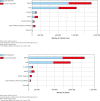Update in global trends and aetiology of hepatocellular carcinoma
- PMID: 30455585
- PMCID: PMC6238087
- DOI: 10.5114/wo.2018.78941
Update in global trends and aetiology of hepatocellular carcinoma
Abstract
Hepatocellular carcinoma (HCC) is the most common primary cancer of the liver responsible for an increasing number of cancer-related deaths, especially in developing economies of Asia and Africa. A plethora of risk factors have been described in the literature. Some of the important ones include chronic viral hepatitis, liver cirrhosis, environmental toxins such as aflatoxin, non-alcoholic fatty liver disease, lifestyle factors like alcohol consumption, smoking, and dietary factors, metabolic diseases like diabetes mellitus and obesity, and genetic and hereditary disorders. The development of HCC is complex involving sustained inflammatory damage leading to hepatocyte necrosis, regeneration, and fibrotic deposition. It also poses multiple challenges in diagnosis and treatment despite advances in diagnostic, surgical, and other therapeutic advancements. This is a narrative review of findings of multiple studies that were retrieved from electronic databases like PubMed, MEDLINE, Embase, Google Scholar, Scopus, and Cochrane. We summarise the current knowledge regarding the epidemiology and various risk factors for the development of HCC with a brief note on various prevention strategies.
Keywords: HBV; HCC; aetiology; epidemiology; hepatitis C; hepatocellular carcinoma; incidence; mortality; prevalance; risk factors.
Conflict of interest statement
The authors declare no conflict of interest.
Figures




References
-
- Choo SP, Tan WL, Goh BK, Tai WM, Zhu AX. Comparison of hepatocellular carcinoma in Eastern versus Western populations. Cancer. 2016;122:3430–3446. - PubMed
-
- Erfani Karimzadeh Toosi A. ERRATUM for the paper Erfani A. Liver Fibrosis: Causes and Methods of Assessment. A Review. Rom J Intern Med. 2015;53(4):304–14. Rom J Intern Med 2017; 55: 121. - PubMed
-
- Pinyol R, Montal R, Takayama T, et al. Molecular predictors of recurrence prevention with sorafenib as adjuvant therapy in hepatocellular carcinoma: Biomarker study of the STORM phase III trial. J Hepatol. 2017;66:S12–S13.
-
- Ferlay J, Ervik M, Lam F, et al. Global Cancer Observatory: Cancer Today. Lyon: International Agency for Research on Cancer; 2018. Available from: https://gco.iarc.fr/today (accessed: 18.09.2018)
Publication types
LinkOut - more resources
Full Text Sources
Medical
